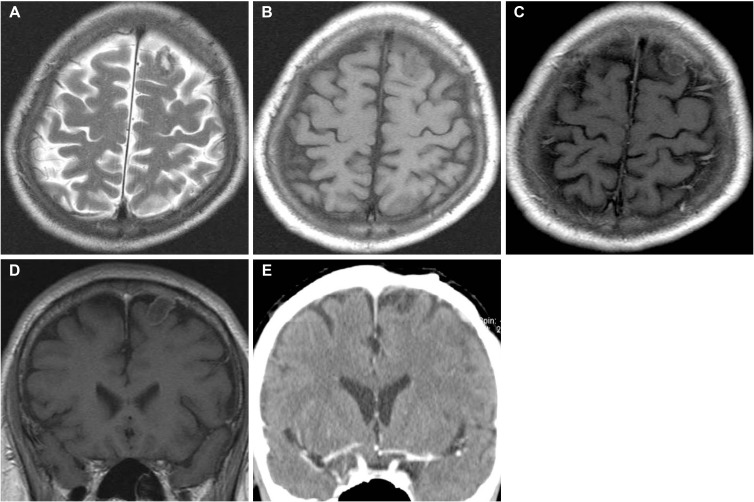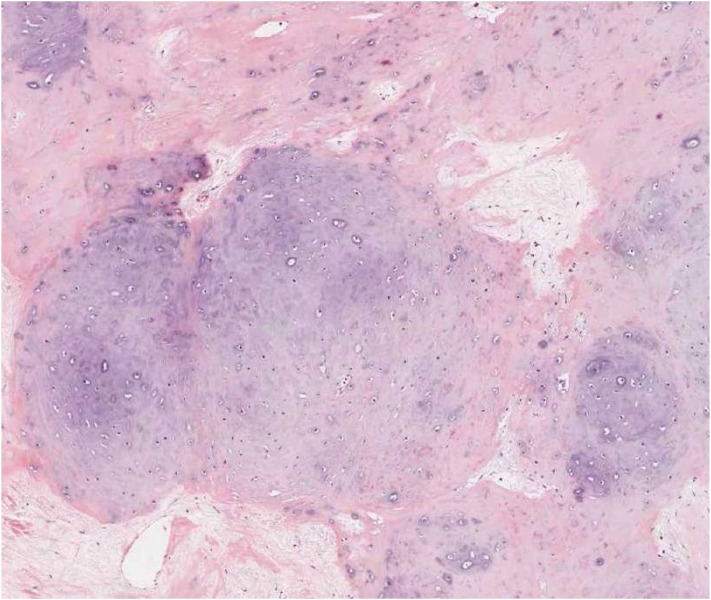Brain Tumor Res Treat.
2020 Apr;8(1):62-65. 10.14791/btrt.2020.8.e8.
An Intracerebral Type of Cranial Chondroma
- Affiliations
-
- 1Department of Neurosurgery, Dongsan Hospital, Keimyung University School of Medicine, Daegu, Korea
- KMID: 2500124
- DOI: http://doi.org/10.14791/btrt.2020.8.e8
Abstract
- The vast majority of intracranial chondromas are located in the base of the cranium. Their presentation as an intracerebral neoplasm is considered to be extremely rare. A previously healthy 45-year-old man experienced recurrent seizure attacks over a period of 6 months. Imaging studies of the brain revealed an ovoid and calcified mass which involve the cortex in the left frontal lobe. Intraoperatively, the mass had no adhesion to the dura and arachnoid membrane. The tumor was completely removed and the final diagnosis was intracerebral chondroma. The patient remained free of disease over the period of 18-years follow-up. This communication adds an unusual case to the literature on the chondroma that expressed in the form of an intra-axial space-occupying lesion in the frontal lobe.
Keyword
Figure
Reference
-
1. Sullivan JC, Goldsmith J, Rojas R, Varma H, Kasper EM. Intracranial dural parafalcine chondroma: case report and systematic review of the literature. World Neurosurg. 2019; 122:1–7. PMID: 30273721.2. Weng JC, Li D, Li H, et al. Surgical management and outcomes of intracranial chondromas: a single-center case series of 66 patients. World Neurosurg. 2017; 108:264–277. PMID: 28867324.3. Fountas KN, Stamatiou S, Barbanis S, Kourtopoulos H. Intracranial falx chondroma: literature review and a case report. Clin Neurol Neurosurg. 2008; 110:8–13. PMID: 17913345.4. Nakayama M, Nagayama T, Hirano H, Oyoshi T, Kuratsu J. Giant chondroma arising from the dura mater of the convexity. Case report and review of the literature. J Neurosurg. 2001; 94:331–334. PMID: 11213975.5. Chorobski J, Jarzymski J, Ferens E. Intracranial solitary chondroma. Surg Gynecol Obstet. 1939; 68:677–686.6. Ahyai A, Spoerri O. Intracerebral chondroma. Surg Neurol. 1979; 11:431–433. PMID: 483149.7. Oktay K, Dere UA, Arslan M, Kesen S, Ciftci T. Intracranial chondroma without meningeal attachment. Neurol India. 2018; 66:865–866. PMID: 29766963.8. Jin Y, Zhang X, Ge J, Zhang S, Liu Q, Qiu Y. Chondroma located in cerebral parenchyma without meningeal attachment. J Craniofac Surg. 2012; 23:1910–1912. PMID: 23172440.9. Zhan RY, Pan XF, Wan S, et al. Solitary intracerebral chondroma without meningeal attachment: a case report with review of the literature. J Int Med Res. 2011; 39:675–681. PMID: 21672374.10. Peltonen E, Suess O, Koenneker M, Brock M, Kombos T. Atypical location of a solitary intracranial chondroma without meningeal attachment. Zentralbl Neurochir. 2007; 68:83–86. PMID: 17614089.11. Geng S, Zhang J, Zhang LW, et al. Diagnosis and microsurgical treatment of chondromas and chondrosarcomas of the cranial base. Oncol Lett. 2014; 8:301–304. PMID: 24959265.12. Abeloos L, Maris C, Salmon I, Balériaux D, Sadeghi N, Lefranc F. Chondroma of the dural convexity: a case report and literature review. Neuropathology. 2012; 32:306–310. PMID: 22017366.13. Hirvonen J, Heikinheimo H. A case of intracerebral chondroma. A case report. Acta Pathol Microbiol Scand. 1969; 76:19–24. PMID: 5350748.14. Feierabend D, Maksoud S, Lawson McLean A, Koch A, Kalff R, Walter J. Giant convexity chondroma with meningeal attachment. Clin Neurol Neurosurg. 2018; 169:37–40. PMID: 29609117.15. Hong JT, Lee SW, Son BC, Sung JH, Choi HC, Kim MC. Delayed occurrence of intracranial supratentorial chondroma following compound depressed skull fracture. Acta Neurochir (Wien). 2005; 147:343–345. discussion 345. PMID: 15605200.16. Tibbs RE, Bowles AP, Raila FA. Maffucci's syndrome and intracranial chondrosarcoma. Skull Base Surg. 1997; 7:49–55. PMID: 17171008.17. Nakase H, Nagata K, Yonezawa T, Morimoto T, Sakaki T. Extensive parasellar chondroma with Ollier's disease. Acta Neurochir (Wien). 1998; 140:100–101. PMID: 9522917.18. Xin Y, Hao S, Zhang J, et al. Microsurgical treatment of intracranial chondroma. J Clin Neurosci. 2011; 18:1064–1071. PMID: 21719289.19. Rosenberg AE, Nielsen GP, Keel SB, et al. Chondrosarcoma of the base of the skull: a clinicopathologic study of 200 cases with emphasis on its distinction from chordoma. Am J Surg Pathol. 1999; 23:1370–1378. PMID: 10555005.20. Colpan E, Attar A, Erekul S, Arasil E. Convexity dural chondroma: a case report and review of the literature. J Clin Neurosci. 2003; 10:106–108. PMID: 12464537.21. Schmidinger A, Rosahl SK, Vorkapic P, Samii M. Natural history of chondroid skull base lesions--case report and review. Neuroradiology. 2002; 44:268–271. PMID: 11942386.22. Cherekaev VA, Golbin DA, Gasparyan TG, Shishkina LV, Tsukanova TV. Management of craniofacial chondroid tumors. J Craniofac Surg. 2015; 26:10–18. PMID: 25569383.23. Abdelhamid K, Camras LR, Nijensohn EM, Rosseau GL, Cerullo LJ. Intracranial chondroma arising from the cranial vault: CT and MR appearance. J Comput Assist Tomogr. 1996; 20:556–558. PMID: 8708055.24. Duan F, Qiu S, Jiang J, et al. Characteristic CT and MRI findings of intracranial chondroma. Acta Radiol. 2012; 53:1146–1154. PMID: 22983260.25. Tanohata K, Maehara T, Aida N, et al. Computed tomography of intracranial chondroma with emphasis on delayed contrast enhancement. J Comput Assist Tomogr. 1987; 11:820–823. PMID: 3655044.
- Full Text Links
- Actions
-
Cited
- CITED
-
- Close
- Share
- Similar articles
-
- A Case of Chondroma in Middle Cranial Fossa: Case Report
- Giant Extra-Capsular Synovial Chondroma of the knee joint: A Case Report
- Chondroma of Soft Tissue: A Case Report
- Subungual Hypervascular Soft Tissue Chondroma Mimicking a Glomus Tumor: A Case Report
- A Case of Extraskeletal Chondroma of External Auditory Canal



